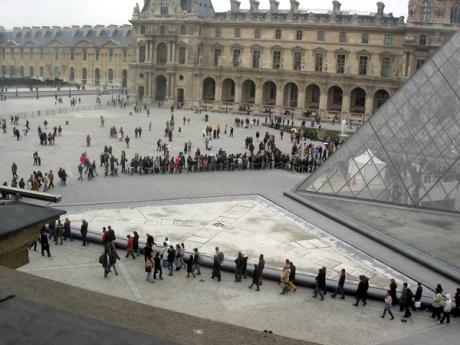Do Not Pass Go
2011 - Sculpture (Sculpture)
57H x 49W x 56D inches
Jason Meadows
Jason Meadows’s Do Not Pass Go (2011) depicts Richie Rich, “the poor little rich boy” of the 1950s comic strip. As his steel outline gleefully makes off with a bag of money and a stack of bills, another icon of affluent America, Uncle Pennybags (otherwise known as the Monopoly Man), is crushed underfoot between two heavy blocks. Behind them lies a broken piggy bank, depicted upside down with eyes X-ed out. The scene represents the collision of two fictional worlds—both geared toward children—in which being well moneyed is assumed to be a universal aspiration. With the free market unleashed, these two nostalgic, seemingly innocuous figures are made to compete against one another in a confrontation that begins to read as sinister.
The Los Angeles–based artist Jason Meadows uses found and manufactured objects to craft idiosyncratic assemblages. Though smart and studied, his constructions are hardly academic. Rich in character development, narrative, and humor, they suggest a position of critical kinship with comics, cartoons, and Hollywood films.
Colors:
Related works sharing similar palette

© » KADIST
Leslie Shows
Human Quarry is a large work on paper by Leslie Shows made of a combination of acrylic paint and collage...

© » KADIST
Edgar Arceneaux
2006Untitled (Wheelchair Drawing) is a ten-foot photo transfer of the image of a wheelchair with burning embers in its seat...

© » KADIST
Saturday, March 3 3pm to 4.30pm Exhibition Walkthrough of If These Stones Could Sing and Falling Wall , performance by Public Movement Curator Marie Martraire will lead a walkthrough of If These Stones Could Sing , a group show on view which focuses on the body as a site to engage the politics of public monuments...

© » KADIST
Elisheva Biernoff
2009In her recent work, Biernoff is interested in investigating fictions and fantasies embedded in the remnants of consumer culture (for example magazines) or through ephemera such as postcards and old photographs...

© » HYPERALLERGIC
7 Art Shows to See in New York, February 2024 Skip to content A detail of Apollinaria Broche’s “I Close My Eyes Then I Drift Away” (2023) at Marianne Boesky Gallery (photo Hrag Vartanian/ Hyperallergic ) The short month of February still packs a lot of art in New York City, from a survey of the influential Godzilla Asian American Arts Network to Apollinaria Broche’s whimsical ceramics and Aki Sasamoto’s experimentations with snail shells and Magic Erasers in her solo show at the Queens Museum...

© » THEARTNEWSPER
Louvre raises ticket prices by 30% in Olympics year Art market Museums & heritage Exhibitions Books Podcasts Columns Technology Adventures with Van Gogh Search Search Museums & Heritage news Louvre raises ticket prices by 30% in Olympics year The price increase will help to subsidise free entry for some visitors and regulate crowd size Gareth Harris 12 December 2023 Share The museum's last ticket raise occurred in 2017 Photo: Inge Knoff via Flickr The Musée du Louvre in Paris is increasing its basic ticket price from €17 to €22 from 15 January as part of a plan to support free admission programmes for some visitors...

© » KADIST
Asli Çavusoglu
2020In the exhibition Pink as a Cabbage / Green as an Onion / Blue as an Orange , Asli Çavusoglu pursues her work on color to delve into an investigation into alternative agricultural systems and natural dyes made with fruits, vegetables, and plants cultivated by the farming initiatives she has been in touch with...

© » KADIST
Yuyan Wang
2022One Thousand and One Attempts to Be an Ocean by Yuyan Wang reflects on the experience of not being able to see the world with depth perception...

© » KADIST
Michael Rakowitz
2017The Ballad of Special Ops Cody by Michael Rakowitz is a serio-comic stop motion animated film in which an everyday African-American G...

© » KADIST
José Castrellón
2016Palo Enceba’o is a project by José Castrellón composed of three photographs, two drawings on metal, and a video work that creates a visual and cultural analogy between the events of January 9th, 1964 in Panama City and the game of palo encebado carried out in certain parts of Panama to celebrate the (US-backed) independence from Colombia...

© » LENS CULTURE
Another America — AI-Generated Photos from the 1940s and 50s - AI-generated images by Phillip Toledano | Interview by Jim Casper | LensCulture Interview Another America — AI-Generated Photos from the 1940s and 50s Phil Toledano has often pushed the boundaries of photography to imagine the future; now he’s tapping into AI to create alternative histories, challenging our belief in any images at all...

© » SLASH PARIS
Romain Best — Coulissements par frictions — Frac île-de-france, le Plateau — Exposition — Slash Paris Connexion Newsletter Twitter Facebook Romain Best — Coulissements par frictions — Frac île-de-france, le Plateau — Exposition — Slash Paris Français English Accueil Événements Artistes Lieux Magazine Vidéos Retour Romain Best — Coulissements par frictions Exposition Installations, sculpture, techniques mixtes Romain Best, Coulissements par frictions, 2023 © Romain Best Romain Best Coulissements par frictions Encore 27 jours : 9 novembre 2023 → 7 janvier 2024 Présenté dans la Project Room du Plateau, Romain Best est né en 1995 à Lyon...

© » KADIST
Marcelo Cidade
2014450 Hayes Street (excavation site) by Marcelo Cidade is a large scale photograph documenting the artist’s excavation of a parking lot located at 450 Hayes Street in San Francisco, a former section of the city’s Central freeway and current condominium site...







